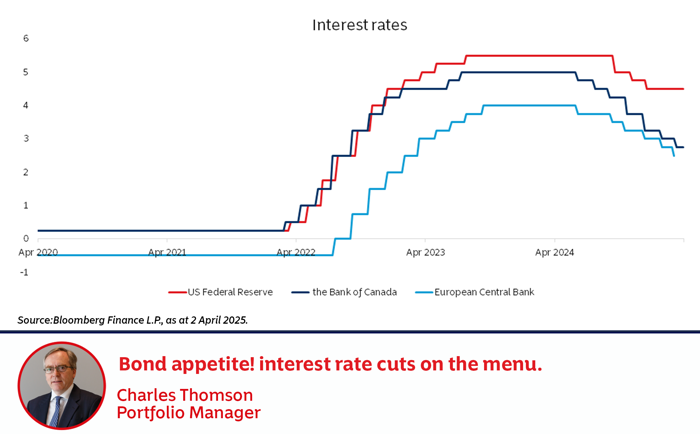
What this chart shows
This chart shows the level of official short-term interest rates set by the US Federal Reserve, the Bank of Canada and the European Central Bank. In 2022 these central banks started to aggressively increase interest rates before reaching a peak in late 2023. Last year monetary policy began to reverse, and interest rates have been falling consistently since then.
Why this is important
The speed and magnitude of the rate increases in 2022 and 2023 were unprecedented in recent history - a necessary policy response to the inflation shock that followed the Covid pandemic and the Russia / Ukraine conflict. Inflation rates declined sharply from the middle of 2022 and have now stabilised at a level close to 2 percent. Policy responses must consider future price stability and economic growth. Recent geopolitical events, specifically US trade tariffs, have caused a fall in asset prices and a downward revision to growth outlooks globally. Further monetary policy easing (rate cuts) now appears necessary given the weaker economic outlook. In the US, the Federal Reserve needs to catch up with Canadian and European authorities and lower the funds rate in the near term. Lower interest rates are generally positive for the fixed income asset class therefore we expect bonds to perform well over the medium term.
The imposition of aggressive tariffs by the US prompted retaliatory actions from countries like China, the EU, and the UK, leading to widespread market declines, heightened fears of a global recession, and increased uncertainty in both developed and emerging markets.

-
President Donald Trump imposed aggressive tariffs of up to 25% on imports from China, Canada, and Mexico, aiming to revive American manufacturing.
-
These tariffs led to a significant sell-off in global stock markets, with the Dow Jones Industrial Average, S&P 500, and Nasdaq Composite all experiencing substantial declines.
-
Economists expressed concerns about rising inflation and the potential for a global recession due to these trade tensions. JP Morgan raised global recession odds to 60%.
-
Over 50 countries initiated trade talks with the US in response to the new tariffs, seeking exemptions or adjustments to avoid economic fallout.

-
UK Prime Minister Keir Starmer ordered a significant reset of economic policies in response to US tariffs, including a 10% base tariff on UK imports.
-
The FTSE 100 index plummeted over 7% during the week, marking its worst performance since March 2020, as investors reacted to trade uncertainties.
-
British businesses, notably Jaguar Land Rover (JLR), faced operational challenges, with JLR pausing US shipments to adapt to new trade conditions.
-
The UK government considered raising taxes or altering fiscal rules to increase borrowing and stimulate growth amid fears of a prolonged recession.

-
The EU prepared retaliatory measures against US tariffs, targeting $28 billion worth of American imports in response to new trade barriers.
-
European Commission President Ursula von der Leyen proposed a fund mobilising nearly €800 billion for defence investments, including military aid for Ukraine, amid heightened geopolitical tensions.
-
European stock markets, including the DAX 40, experienced sharp declines due to concerns over escalating trade tensions and potential economic fallout.
-
The EU faced internal debates on adjusting fiscal rules and policies to counteract potential economic downturns resulting from trade conflicts with the US.

-
China's stock markets showed relative resilience, with the Shanghai Composite index falling only 0.6% in USD terms over the week, despite global market volatility triggered by trade tensions.
-
The Chinese government expanded controls on business dealings with key US companies, aiming to counteract US trade measures and protect domestic interests.
-
Japan's Nikkei 225 index declined by 4% in USD terms amid global market volatility driven by US tariff announcements and escalating trade tensions.
-
Global markets, including those in emerging economies, experienced heightened volatility as investors reacted to trade tensions and potential recession risks.
